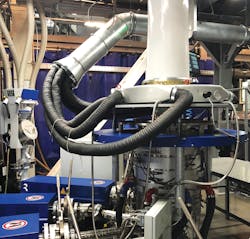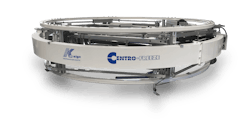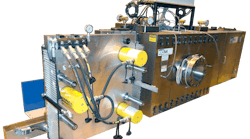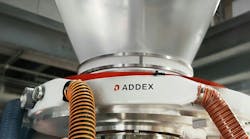At an open house this spring, Reifenhäuser launched its Evolution five-layer blown film line for producing form-fill-seal (FFS) film.
The open house was held at KZPM, a Kazan, Russia, maker of polymeric films and flexible packaging and Reifenhäuser’s first customer for the new line. The line is designed to produce film for heavy-duty shipping sacks for packaging petrochemicals.
“What is new is five layers,” said Steve DeSpain, Reifenhäuser’s VP of sales and marketing. “Historically, these FFS bags, particularly for resin sacks, have always been made as a three-layer product. We call this our Evolution 5L FFS line.”
Reifenhäuser introduced the line to meet market demand for thinner film.
“Our Evolution five-layer FFS line offers significant advantages over conventional three-layer films, including higher output, improved dart impact, improved puncture resistance and the option of using recycled material as the core layer,” said Bernd Schroeter, director of product management.
Costs are reduced because the thinner outer layers require smaller quantities of additives and resin, and producers can use cheaper, recycled resin in the core layer, Schroeter said.
Evolution blown film die heads produce precise layer thicknesses and require short start-up and change-over times, the company said.
“The die head is new specifically for this application,” DeSpain said. “[It’s] five layers with center-holed IBC [internal bubble cooling] at 175mm diameter and rates up to 480 kilograms [1,058 pounds] per hour. The reality of having five layers versus the conventional three layers allows producers to tailor their structure/recipes, etc., to take advantage of thinner skin layers.”
As a result, producers can use smaller quantities of additives and avoid higher-cost polymers while not losing desired properties. That can save money.
The line demonstrated at KZPM achieved an output of 949 pounds per hour when making film with a thickness of 125 micrometers , the company said.
Bruce Geiselman, senior staff reporter
Contact:
Reifenhäuser Inc. Maize, Kan., 316-260-2122,







